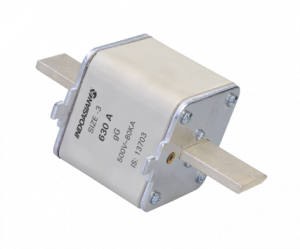A fuse is a crucial electrical safety tool that guards against fire risks and mishaps. A failure in the network, such as a phase-to-ground or phase-to-phase short circuit, happens after the current flow in the network exceeds the predetermined limit. Equipment connected to the network will suffer permanent damage when the current flow may have a high thermal effect.
An electrical fuse is utilised to counteract this damage caused by errors. An electrical device with a conductor is a fuse. Once the current flow surpasses the preset value, this conductor melts quickly and splits the circuit connection. So, the weakest link in an electrical circuit is here.
The HRC Fuse‘s operating principle is that, under normal circumstances, the current passing through the element is not strong enough to melt it. High-resistance material that aids in putting out the arc is produced due to the chemical reaction between the vapour of the fuse element and the filler powder.
What is HRC?
High rupturing capacity (HRC) fuses have a wire or component that can carry a high short-circuit current for a predetermined time. It does not blow off if the defect is fixed during this time; if not, it melts or blows off.
An HRC fuse is special because it won’t blow off even if there is an excess of current if the electrical system’s issue is corrected within the allotted time. But after that predetermined time, the fuse wire melts, cutting off the electricity.
Where is HRC used?
These fuses can be used for the following things.
- In HV switchgear, HRC fuses are used to guard against short circuits.
- Secondary safety measures safeguard electrical equipment such as motors, transformers, cars, etc.
- These fuses are utilised in the motor stators.
Why is HRC used?
Most HRC fuses are designed for use in industrial settings where cables and equipment must be protected at greater voltages and amperages. For the protection of low voltage/low amperage requirements of consumer electronics or automotive applications, HRC fuses are typically not necessary. As a result, most HRC fuses frequently have 415V or greater ratings. The most popular HRC fuse types include British Standard BS88, American or European cartridges, and DIN NH blade fuses.
How is it used?
The heat produced by I2RF makes fuses functional after their element melts. Here, RF stands for the fuse’s resistance, and the heat produced increases as the current through the fuse increases. A fuse element will soften more quickly for large fault currents than for smaller ones.
HRC Fuse Types
These fuses come in three different varieties, which are as follows:
- NH Type Fuse
This fuse provides short-circuit and overload protection for low and medium voltage.
- Blade Type
Typically, these are utilised in automobiles to provide safety against short circuits, wiring, and backup protection in motors.
- Din Type Fuse
These serve to protect the transformer and are accessible at various voltage levels. This has a great capability for cleaning.
IndoAsian‘s High Rupture Capacity (HRC) fuses feature high-breaking capacities ranging from 80kA to 120kA at 500V AC.
The user-friendliness of these HRC fuses is exceptional. These HRC fuses also include backup protection, reduced electromagnetic stress, low watt loss, low let-through energy, low cut-off characteristics, and low cut-off characteristics incorporated into them for a longer lifespan.
To select from a wide selection of HRC fuses, go to IndoAsian. Buy today!

